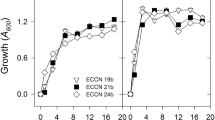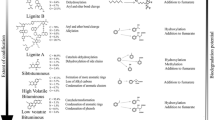Abstract
Coal is one of the major sources of energy, fuel, and other related chemicals. The processes to utilize coal for energy, fuel and other chemicals such as coal combustion, liquefaction, carbonization, and gasification pose a great threat to the environment by emitting toxic particles and CO2 to the atmosphere. Thus, biological beneficiation of coal can be a good strategy to utilize coal with environmental sustainability. Here, we report the screening of microorganisms able to degrade or depolymerize coal. These host strains are potential candidates for the development of biological treatment process of coal. A total of 45 microbial strains were isolated from sludge enriched with coal and were identified based on 16S rRNA sequencing. Four strains of three genera, Cupriavidus sp., Pseudomonas sp., and Alcaligenes sp., were further characterized for their abilities to degrade coal. The degree of coal degradation was analyzed by measuring the increase in absorbance at 450 nm by UV spectroscopy. These microorganisms were also able to increase the pH of the culture media as a response to the acidic nature of coal. Laccase-like activity was also found in these strains when tested for RBBR dye degradation. Since biological degradation of coal through the use of microorganisms is a good alternative to chemical combustion of coal, microbial strains isolated in this study can be potential biological catalysts for coal conversion into valuable chemicals.
Similar content being viewed by others
References
Fakoussa, R. M. and M. Hofrichter (1999) Biotechnology and microbiology of coal degradation. Appl. Microbiol. Biotechnol. 52: 25–40.
Machnikowska, H., K. Pawelec, and A. Podgórska (2002) Microbial degradation of low rank coals. Fuel Proc. Technol. 77: 17–23.
Gokcay, C. F., N. Kolankaya, and F. B. Dilek (2001) Microbial solubilization of lignites. Fuel 80: 1421–1433.
Selvi, A. V., R. Banerjee, L. C. Ram, and G. Singh (2009) Biodepolymerization studies of low rank Indian coals. World J. Microbiol. Biotechnol. 25: 1713–1720.
Reiss, J. (1992) Studies on the solubilization of German coal by fungi. Appl. Microbiol. Biotechnol. 37: 830–832.
Schobert H. H. and C. Song (2002) Chemicals and materials from coal in the 21st century. Fuel 81: 15–32.
Silva-Stenico, M. E., C.J. Vengadajellum, H. A. Janjua, S. T. L. Harisson, S. G. Burton, and D. A. Cowan (2007) Degradation of low rank coal by Trichoderma atroviride ES11. J. Ind. Microbiol. Biotechnol. 34: 625–631.
Romanowska I., B. Strzelecki, and S. Bielecki (2015) Biosolubilization of Polish brown coal by Gordonia alkanivorans S7 and Bacillus mycoides NS1020. Fuel Proc. Technol. 131: 430–436.
Quigley, D. R., B. Ward, D. L. Crawford, H. J. Hatcher, and P. R. Dugan (1989) Evidence that microbially produced alkaline materials are involved in coal biosolubilization. Appl. Biochem. Biotechnol. 20: 753–763.
Jiang, F., Z. Li, Z. Lv, T. Gao, J. Yang, Z. Qin, and H. Yuan (2013) The biosolubilization of lignite by Bacillus sp. Y7 and characterization of the soluble products. Fuel 103: 639–645.
Cohen, M. S., K. A. Feldman, C. S. Brown, and E. T. Gray Jr. (1990) Isolation and identification of the coal-solubilizing agent produced by Trametes versicolor. Appl. Environ. Microbiol. 56: 3285–3291.
Yuan, H., J. Yang, and W. Chen (2006) Production of alkaline materials, surfactants and enzymes by Penicillium decumbens strain P6 in association with lignite degradation/solubilization. Fuel 85: 1378–1382.
Shi, K. Y., X. X. Tao, S. D. Yin, Y. Du, and Z. P. Lv (2009) Bioliquefaction of Fushun lignite: Characterization of newly isolated lignite liquefying fungus and liquefaction products. Procedia Earth Planet. Sci. 1: 627–633.
Basaran, Y. A., B. Sakintuna, A. Taralp, and Y. Yurum (2003) Bio-liquefaction/solubilization of low-rank Turkish lignites and characterization of the products. Energy & Fuels 17: 1068–1074.
Gao, T. G., F. Jiang, J. S. Yang, B. Z. Li, and H. L. Yuan (2012) Biodegradation of Leonardite an Alkali-producing bacterial community and characterization of the degraded products. Appl. Microbiol. Biotechnol. 93: 2581–2590.
Pokorny, R., P. Olejnikova, M. Balog, P. Zifcak, U. Holker, M. Janssen, J. Bend, M. Hofer, R. Holiencin, D. Hudecova, and L. Varecka (2005) Characterization of microorganisms isolated from lignite excavated from the Záhorie coal mine (southwestern Slovakia). Res. Microbiol. 156: 932–943.
Huang X., N. Santhanam, D.V. Badri, W.J. Hunter, D. K. Manter, S. R. Decker, J. M. Vivanco, and K. F. Reardon (2013) Isolation and characterization of lignin-degrading bacteria from rainforest soils. Biotechnol. Bioeng. 110: 1616–1626.
Yin S., X. Tao, K. Shi, and Z. Tan (2009) Biosolubilization of Chinese lignite. Fuel 34: 775–781.
Sambrook, J. R. and D. W. Russell (2001) Molecular cloning: A laboratory manual. New York Cold Spring Harbor Laboratory, NY, USA.
Kiiskinen, L. L., M. Ratto, and K. Kruus (2004) Screening for novel laccase-producing microbes. J. Appl. Microbiol. 97: 640–646.
Schraa, G., M. L. Boone, M. S. Jetten, A. R. van Neerven, P. J. Colberg, and A. J. Zehnder (1986) Degradation of 1, 4-dichlorobenzene by Alcaligenes sp. strain A175. Appl. Environ. Microbiol. 52: 1374–1381.
Claus, G. and H. J. Kutzner (1983) Degradation of indole by Alcaligenes spec. Syst. Appl. Microbiol. 4: 169–180
Krooneman, J., E. B. Wieringa, E. R. Moore, J. Gerritse, R. A. Prins, and J. C. Gottschal (1996) Isolation of Alcaligenes sp. strain L6 at low oxygen concentrations and degradation of 3-chlorobenzoate via a pathway not involving (chloro) catechols. 62: 2427–2434.
Menke, B. and H. J. Rehm (1992) Degradation of mixtures of monochlorophenols and phenol as substrates for free and immobilized cells of Alcaligenes sp. A7-2. Appl. Microbiol. Biotechnol. 37: 655–661.
Leonard, D., C. B. Youssef, C. Destruhaut, N. D. Lindley, and I. Queinnec (1999) Phenol degradation by Ralstonia eutropha: Colorimetric determination of 2-hydroxymuconate semialdehyde accumulation to control feed strategy in fed-batch fermentations. Biotechnol. Bioeng. 65: 407–415.
Louie, T. M., C. M. Webster, and L. Xun (2002) Genetic and biochemical characterization of a 2, 4, 6-trichlorophenol degradation pathway in Ralstonia eutropha JMP134. J. Bacteriol. 184: 3492–3500.
Jimenez, J. I., B. Miñambres, J. L. Garcia, and E. Diaz (2002) Genomic analysis of the aromatic catabolic pathway from Pseudomonas putida KT2440. Environ. Microbiol. 4: 824–841.
McMahon, A. M., E. M. Doyle, S. Brooks, and K. E. O’Connor (2007) Biochemical characterisation of the coexisting tyrosinase and laccase in the soil bacterium Pseudomonas putida F6. Enz. Microb. Technol. 40: 1435–1441.
Garg, S. K., M. Tripathi, S. K. Singh, and J. K. Tiwari (2012) Biodecolorization of textile dye effluent by Pseudomonas putida SKG-1 (MTCC 10510) under the conditions optimized for monoazo dye orange II color removal in simulated minimal salt medium. Int. Biodeterior. Biodegrad. 74: 24–35.
Chen, C. C., H. J. Liao, C. Y. Cheng, C. Y. Yen, and Y. C. Chung (2007) Biodegradation of crystal violet by Pseudomonas putida. Biotechnol. Lett. 29: 391–396.
Berezina, N. B., and R. Lefebvre (2015) From organic pollutants to bioplastics: Insights into the bioremediation of aromatic compounds by Cupriavidus necator. New Biotechnol. 32: 47–53.
Trefault, N., R. DE la Iglesia, A. M. Molina, M. Manzano, T. Ledger, D. Perez-Pantoja, M. A. Sanchez, M. Stuardo, and B. Gonzales (2004) Genetic organization of the catabolic plasmid pJP4 from Ralstonia eutropha JMP134 (pJP4) reveals mechanisms of adaptation to chloroaromatic pollutants and evolution of specialized chloroaromatic degradation pathways. Environ. Microbiol. 6: 655–668.
Plumeier, I., D. Perez-Pantoja, S. Heim, B. Gonzales, and D. H. Pieper (2002) Importance of different tfd genes for degradation of chloroaromatics by Ralstonia eutropha JMP134. J. Bacteriol. 184: 4054–4064.
Makkar, N. S. and L. E. Casida Jr. (1987) Cupriavidus necator gen. nov., sp. nov.; A Nonobligate bacterial predator of bacteria in soil. Int. J. Syst. Evol. Microbiol. 37: 323–326.
Cowles, C. E., N. N. Nichols, and C. S. Harwood (2000) BenR, a XylS homologue, regulates three different pathways of aromatic acid degradation in Pseudomonas putida. J. Bacteriol. 182: 6339–6346.
Tuleva, B. K., G. R. Ivanov, and N. E. Christova (2002) Biosurfactant production by a new Pseudomonas putida strain. Zeitschrift für Naturforschung C 57: 356–360.
Shi, Y., L. Chai, C. Tang, Z. Yang, H. Zhang, R. Chen, Y. Chen, and Y. Zheng (2013) Characterization and genomic analysis of kraft lignin biodegradation by the beta-proteobacterium Cupriavidus basilensis B-8. Biotechnol. Biofuels 6:1.
Simmons, J. S. (1926) A culture medium for differentiating organisms of typhoid-colon aerogenes groups and for isolation of certain fungi. The J. Infect. Diseases 39: 209–214.
Shi, K. Y., S. D. Yin, X. X. Tao, Y. Du, H. He, Z. P. Lv and N. Xu (2013) Quantitative measurement of coal bio-solubilization by ultraviolet-visible spectroscopy. Energy Sources, Part A 35: 1456–1462.
Engesser, K. H., C. Dohms, and A. Schmid (1994) Microbial degradation of model compounds of coal and production of metabolites with potential commercial value. Fuel Proc. Technol. 40: 217–226.
Fukuoka, K., K. Tanaka, Y. Ozeki, and R. A. Kanaly (2015) Biotransformation of indole by Cupriavidus sp. strain KK10 proceeds through N-heterocyclic-and carbocyclic-aromatic ring cleavage and production of indigoids. Int. Biodeterior. Biodegrad. 97: 13–24.
Matus, V., M. A. Sanchez, M. Martinez, and B. Gonzales (2003) Efficient degradation of 2, 4, 6-trichlorophenol requires a set of catabolic genes related to tcp genes from Ralstonia eutropha JMP134 (pJP4). Appl. Environ. Microbiol. 69: 7108–7115.
Park, S. J., T. W. Kim, M. K. Kim, S. Y. Lee, and S. C. Lim (2012) Advanced bacterial polyhydroxyalkanoates: towards a versatile and sustainable platform for unnatural tailor-made polyesters. Biotechnol. Adv. 30: 1196–1206.
Lu, J., C. J. Brigham, C. S. Gai, and A. J. Sinskey (2012) Studies on the production of branched-chain alcohols in engineered Ralstonia eutropha. Appl. Microbiol. Biotechnol. 96: 283–297.
Oh, Y. H., I. Y. Eom, J. C. Joo, J. H. Yu, B. K. Song, S. H. Lee, S. H. Hong, and S. J. Park (2015) Recent advances in development of biomass pretreatment technologies used in biorefinery for the production of bio-based fuels, chemicals and polymers. Kor. J. Chem. Eng. 32: 1945–1959.
Author information
Authors and Affiliations
Corresponding authors
Rights and permissions
About this article
Cite this article
David, Y., Baylon, M.G., Pamidimarri, S.D.V.N. et al. Screening of microorganisms able to degrade low-rank coal in aerobic conditions: Potential coal biosolubilization mediators from coal to biochemicals. Biotechnol Bioproc E 22, 178–185 (2017). https://doi.org/10.1007/s12257-016-0263-9
Received:
Revised:
Accepted:
Published:
Issue Date:
DOI: https://doi.org/10.1007/s12257-016-0263-9




